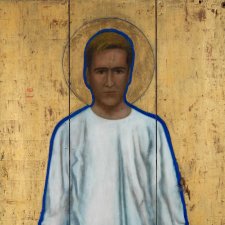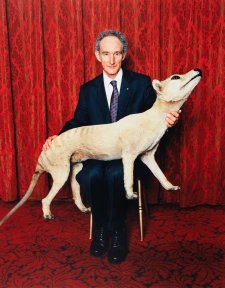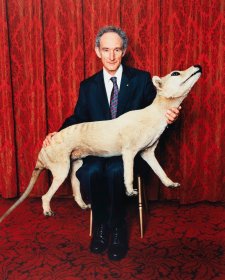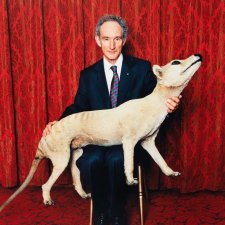Anthony Carden (1961–1995), activist, studied acting in New York in the early 1980s before returning home to work in theatre, film and television in Sydney and Melbourne. After being diagnosed with AIDS, he joined ACTUP (AIDS Coalition to Unleash Power) and became a lobbyist for better standards of medical care, improved hospital facilities, and effective safe sex education. An activist against discrimination in all its forms, he was a prominent advocate for people living with HIV/AIDS. With Clover Moore, then the Member for Bligh in the New South Wales Legislative Assembly, he helped raise $1 million for the refurbishment of St Vincent's Hospital's Ward 17 South, Australia's first dedicated ward for HIV/AIDS patients. He died five years after his diagnosis.
AñA Wojak met Carden at an ACTUP meeting in 1991, at which time the artist had begun working on a series exploring ideas of sainthood and martyrdom. Wojak painted Carden in the guise of Saint Acacius, an early Christian martyr, as he was 'someone who was working for the rights of others whilst at the same time suffering himself'. Employing gold leaf and a blue paint derived from lapis lazuli, the work is intended to evoke Byzantine icons and Italian Renaissance altarpieces. The portrait was displayed in Don't Leave Me This Way: Art in the Age of AIDS at the National Gallery of Australia in 1994–1995; at Carden's wake; and later in Ward 17 South before being purchased by Carden's mother, Lesley Saddington.
Gift of Lesley Saddington 2015
© AñA Wojak
This portrait of Tony Carden, HIV/AIDS activist and lobbyist, by Ana Wojak 1991 is titled Acacius (Stigmata). It is an oil and gold leaf on cedar panel work. It measures 121 cm high, 103 cm wide and protrudes 4 cm off the wall.
Three vertically divided panels make up the painting’s textured wooden surface. The wooden surface is worn, with many dents and old nail holes. Squares of gold leaf have been applied to cover the wood. Overall, the gold leaf is worn and scratched.
A line of vibrant electric blue paint outlines Carden’s figure and hands. This same bold blue also forms a thick border around the uneven outer edge of the artwork. The piece has rounded corners as though the surface of a small old coffee table has been repurposed.
A white-clad Tony Carden stands out against the gold background. His short blond hair is swept over his head to the right. Underneath dark brows his expression is neutral. He is depicted from the hips up, facing front on with his arms at his sides. Either side of his body he holds his hands out, fingers together, palms parallel to the bottom of the frame.
Carden’s stance, combined with the plain white long-sleeved garment he is wearing contrasts starkly with the gold background. A halo-like thin blue line encircles Carden’s head and within its circumference the gold-textured background is slightly smudged and darker than elsewhere.
A small red maker’s mark of the artist’s initials and some script text sits to the left of Carden’s head.
Audio description written and voiced by Kate Matthews
Lesley Saddington (1 portrait)



On one level The Companion talks about the most famous and frontline Australians, but on another it tells us about ourselves.



Angus Trumble provides poignant context for Aña Wojak’s portrait of Tony Carden.



Celebrate the Gallery’s 20th birthday summer with Electric! Portraits that pop! The collection exhibition features a mix of bright, bold and colourful paintings, prints and photographs, and buoyant video portraits.